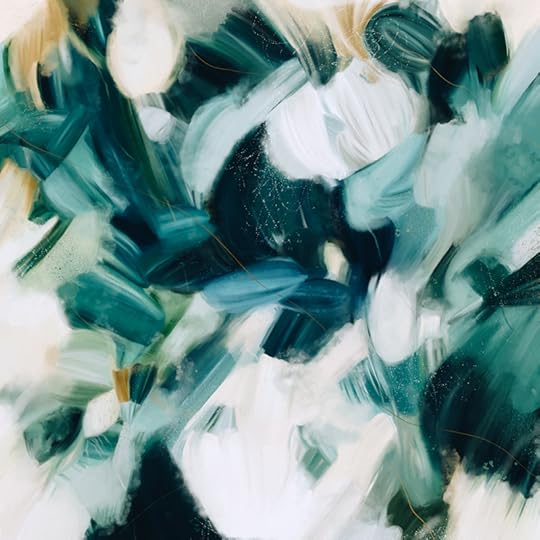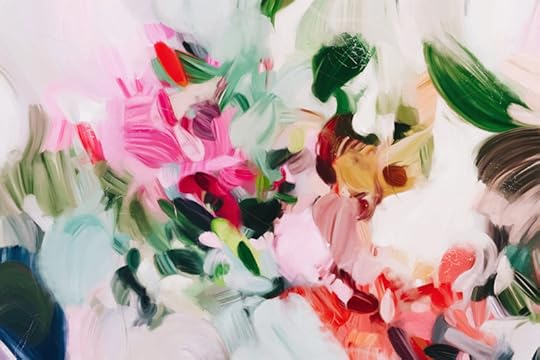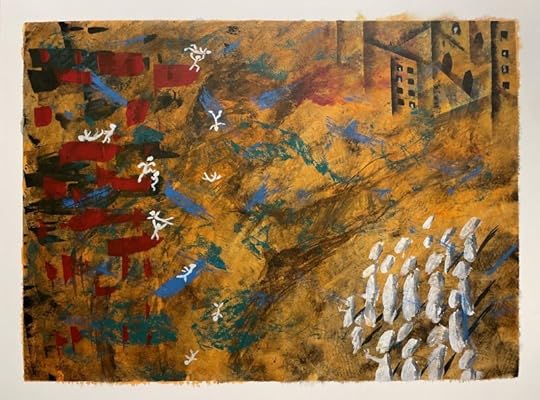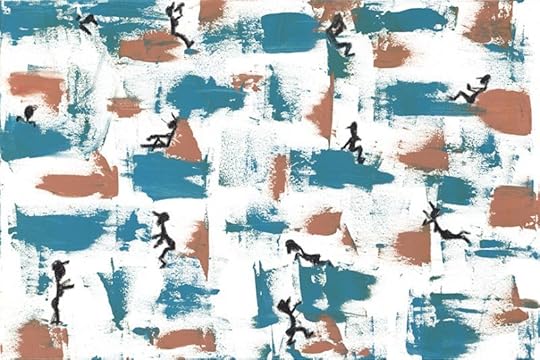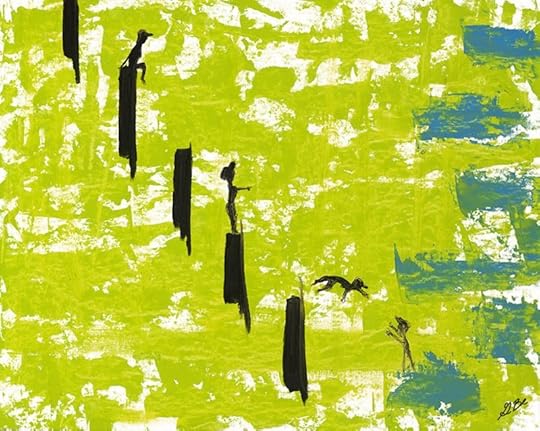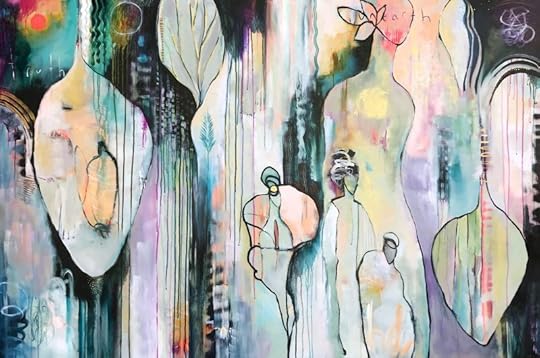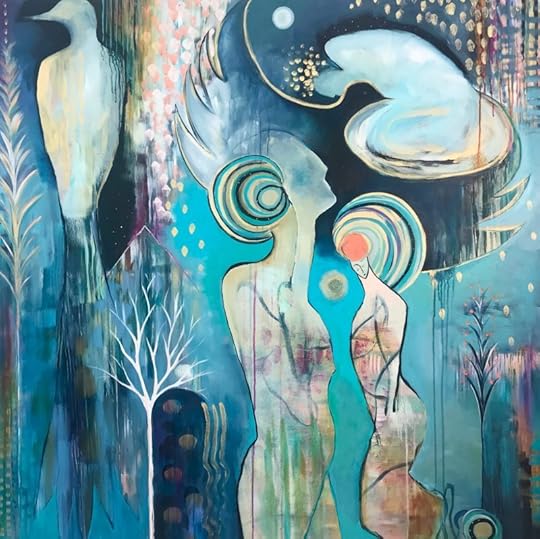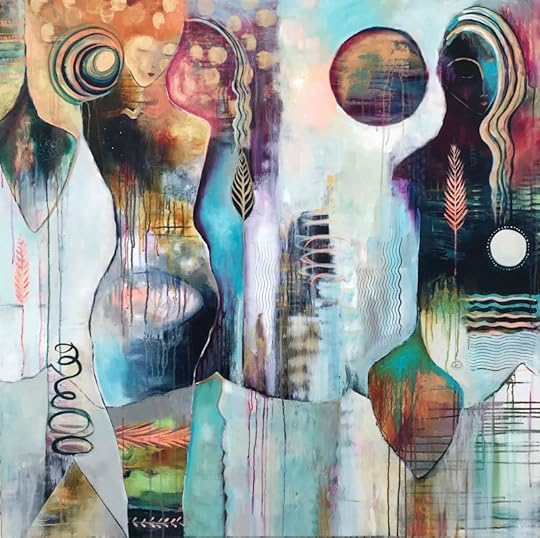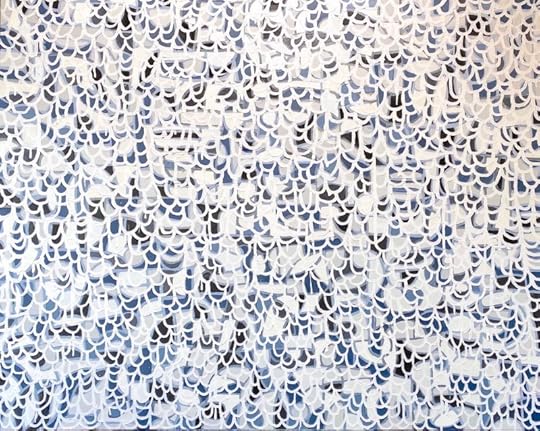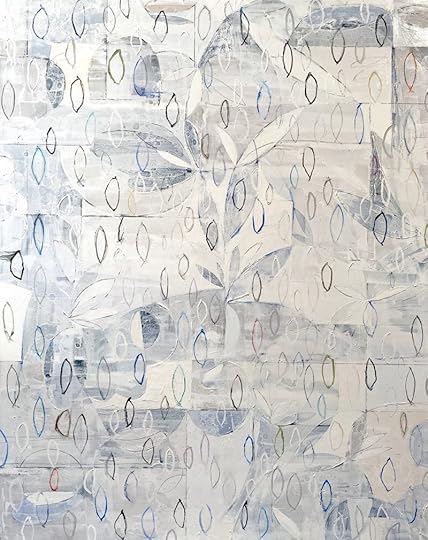Cory Huff's Blog: The Abundant Artist Goodreads blog, page 4
October 27, 2022
Making a Living Creating Digital Fine Art Prints with Patricia Vargas | TAA Podcast Season 5, Episode 14
Welcome to season five, episode 14 of The Abundant Artist, the show that dispels the myth of “the starving artist” and shares how you can live an abundant life as an artist and make a living from your talent one interview at a time.
This week on The Abundant Artist podcast, Cory is thrilled to be joined by a return guest – Patricia Vargas! The last time Patricia was on the podcast was about five years ago – and suffice to say, a lot has changed since then! If you don’t already know Patricia, she is the owner of the renowned Parima Studio. She is a visual artist who combines her passions of painting, designing, and technology to create large-scale, custom, abstract art using her computer as her canvas.
In this episode, Patricia shares what has changed for her since she was last on the podcast, how her art career has evolved, what her experience has been like during the pandemic (and how she has adapted to these changes), and what she does day-to-day to balance her business practices while minimizing distractions. Patricia also offers some advice to other artists who may be interested in getting started in the digital art space and what they can do to market themselves online!
“I think just being available on different platforms, different areas, getting your name out – just general marketing – (is important). You never know who’s looking. You don’t know where they heard about you from. You just never know.” — Patricia Vargas
In this episode:
[:30] Cory welcomes Patricia Vargas back to the podcast!
[:56] What Patricia has been up to for the last five years since she was last on the podcast and how her art career has evolved.
[3:00] What Patricia loves about creating digital paintings.
[3:45] How Patricia’s “nerdiness” shows up in her professional career as a digital painter.
[5:35] How Patricia is selling her digital paintings as prints online.
[7:05] Patricia explains what a general licensing deal looks like for her.
[8:09] Films that Patricia’s work has appeared in.
[8:49] How does Patricia license her work to a hotel? What does that process look like?
[10:40] How did Patricia build up relationships with art consultants?
[12:07] Patricia shares how she got started in being featured in a variety of magazines.
[13:25] Would Patricia agree that blogging in 2010 is what social media is today?
[14:09] How blogging helped Patricia get featured in magazines, in turn, helping her be noticed by art consultants.
[15:32] Does Patricia still do acrylic painting outside of her career with digital painting?
[16:25] Patricia’s favorite tools and technology for digital painting!
[17:37] The difference between the iPad Pro and the XP Pen Tablet.
[18:34] Does Patricia have any favorite Procreate toolsets?
[19:34] What Patricia likes about the XP Pen Tablet.
[20:11] What is the desktop device that Patricia connects her tablet to?
[21:30] How Patricia pivoted and adapted during the pandemic as a digital artist that sells their prints online.
[25:23] How Patricia balances her day-to-day business practices and minimizes distractions.
[27:53] Why has Patricia cut down on which social media platforms she focuses on?
[28:59] How Patricia leverages Pinterest and Tailwind to get leads.
[31:47] How Patricia tracks profitability with her ads.
[32:55] What books is Patricia reading right now?
[36:26] Patricia shares about a new exciting road opening up for her and her business.
[39:49] Cory thanks Patricia for joining the podcast once again!
Resources mentioned:
The Abundant Artist Podcast: “Managing a Successful Print Studio with Patricia Vargas”
Patricia’s Etsy Shop:
Patricia’s Instagram: Parima Studio
Patricia’s Website
Procreate
Apple Pencil
iPad Pro
XP Pen Tablet
Adobe Photoshop
Corel Painter
Creative Market
Epson Printers
Pinterest
Tailwind
The Dutch House, by Ann Patchett
Code Girls, by Liza Mundy
The Innovators, by Walter Isaacson
About the guest:
 Patricia Vargas is a first-generation Mexican-American artist. Using her computer and drawing tablet, she brings together her love of design, botanical gardens, and fantastical spaces to create color-drenched dreamy abstract art with a painterly aesthetic. Her work has been featured in Anthropologie, Domino, Veranda, and Better Homes and Gardens, among others. Additionally, her work has appeared in feature films such as Vox Lux and the TV mini-series Tales of the City. She resides in Los Angeles County, CA, with her husband and three cats.
Patricia Vargas is a first-generation Mexican-American artist. Using her computer and drawing tablet, she brings together her love of design, botanical gardens, and fantastical spaces to create color-drenched dreamy abstract art with a painterly aesthetic. Her work has been featured in Anthropologie, Domino, Veranda, and Better Homes and Gardens, among others. Additionally, her work has appeared in feature films such as Vox Lux and the TV mini-series Tales of the City. She resides in Los Angeles County, CA, with her husband and three cats.
The post Making a Living Creating Digital Fine Art Prints with Patricia Vargas | TAA Podcast Season 5, Episode 14 appeared first on How to Sell Art Online | Online Marketing for Artists.
October 5, 2022
Designing Sets for Platinum Artists, Nightclubs, and Restaurants with Marina Skye | TAA Podcast Season 5, Episode 13
Welcome to season five, episode 13 of The Abundant Artist, the show that dispels the myth of “the starving artist” and shares how you can live an abundant life as an artist and make a living from your talent one interview at a time.
Joining the podcast today is Creative Director and Set Designer Marina Skye! Skye does freelance set design and creative projects for restaurants, recording artists, designers, and clothing stores – just to name a few. Her creative designs have caught the attention of the fine art world; platinum recording artist, Jidenna; the infamous Stankonia studios; 2Chainz’ Street Execs, Mike Will’s Studio; and many more!
“(For set design), we do a walkthrough of the space and the client tells me in their own words what their hopes and dreams (are); what they hope the space (will) look like and feel like. I then go back…create a mood board and a mockup of the space, and I associate that with a budget. I’m really big on my clients knowing where all of their money is going.” — Marina Skye
In this episode, Skye shares her journey as a creative professional and set designer, how she began building out her portfolio when she was first starting out, the exciting doors she has opened from always being open to new challenges and opportunities, the business side of how a set design project works from top to bottom, and what’s to come for the future of her business as she moves onwards and upwards!
In this episode:
[:30] How Skye developed their aesthetic as an artist.
[2:02] About Skye’s background and their pathway as an artist.
[3:15] What Skye studied in college.
[3:29] Skye’s first job out of college and what led them to transition out of it and create their clothing line.
[6:18] How Skye began to develop a portfolio for their set design through decorating parties.
[8:06] Why Skye was OK with working for free while building her portfolio.
[11:28] How Skye’s free work transitioned into paid work.
[16:05] Skye shares about the sorts of opportunities that became available to her after her 6-month nightclub set design project.
[17:47] About Skye’s 3-month set design project, the Trap Music Museum.
[20:55] Skye breaks down the business side of how a set design project works.
[21:45] How the process of working on set design looks like from top to bottom.
[23:30] How Skye builds her mood boards and mockups for her clients.
[25:21] Who pays Skye when it comes to set designs for artists – the label or the artist themselves?
[25:55] The challenges of building set designs to be taken apart and put back up on the daily for touring artists.
[27:55] What Skye is excited about right now as an artist.
[29:50] How did COVID impact Skye’s business?
[32:35] Where to find Skye’s work online!
[33:17] Skye’s plans for the future on how to possibly expand her business.
[35:07] How Skye delegates in her business without being directly hands-on with all of her set designs.
[36:05] Cory thanks Skye for joining the podcast!
Resources mentioned:
Set by Skye
Set by Skye on Instagram
Trap Music Museum
Candytopia
About the guest:
 Marina Skye is an Clio award winning Art Director and Set Designer who is behind some of your most impactful activations, including 21 Savage’s Motel 21, and the Trap Music Museum. In addition, she works as art director and set designer to Epic Records artist, Jidenna where she is responsible for all music video sets and touring stage designs. Her most recent accomplishment is the interior design of Rockstar Energy Drink’s flagship Culture Lab: a 4 story building in the heart of Atlanta dedicated to fostering Atlanta’s creative community with conference rooms, a recording room, podcast room, performance space and gaming center.
Marina Skye is an Clio award winning Art Director and Set Designer who is behind some of your most impactful activations, including 21 Savage’s Motel 21, and the Trap Music Museum. In addition, she works as art director and set designer to Epic Records artist, Jidenna where she is responsible for all music video sets and touring stage designs. Her most recent accomplishment is the interior design of Rockstar Energy Drink’s flagship Culture Lab: a 4 story building in the heart of Atlanta dedicated to fostering Atlanta’s creative community with conference rooms, a recording room, podcast room, performance space and gaming center.
The post Designing Sets for Platinum Artists, Nightclubs, and Restaurants with Marina Skye | TAA Podcast Season 5, Episode 13 appeared first on How to Sell Art Online | Online Marketing for Artists.
September 19, 2022
Antifragile Art Businesses
In his book Antifragile, Nassim Nicholas Taleb explains that some systems become more resilient and work better as they experience stress and chaos. Certain kinds of artmaking tends to behave in an antifragile manner. When randomness and chaos is introduced into the process, the art thrives and just works.
I want to help artists build antifragile businesses. I want to help artists as a group become more antifragile. In order to do that I think the art community needs two things: community and more control over diversified income streams.
Yesterday we held our first TAA Community call. We facilitated breakout sessions with three artists in each room and asked artists to introduce themselves, their art, and something they need help with or can help others with in about 5 minutes per room.
We then brought everyone back into the main room and asked them to share some things that they learned from other artists. I’ll share a few takeaways:
It’s very easy to feel isolated as an artist, and it’s gotten worse since CovidSelling art in person is easier, but reaching people and building an audience works a lot better if it includes online marketingStreet fairs and casual parties often sell better than white box gallery showsWe’re going to do more of these kinds of community calls. More to come on that soon. We’re most likely going to organize an artist show & tell event where artists can show their art, practice a 2-3 minute pitch, and then answer questions and get feedback on their pitch.These kinds of experiments are a lot of fun for me. I love working with artists and helping them develop their marketing pitch.
Related to that last bullet point: one of our course alumni recently held a backyard party where he displayed his art and sold five original pieces. No white box. No critics. Just inviting his friends and collectors to a party. His costs included renting tables and chairs and buying some food.
He stays connected with these folks between events and shows in two ways: email and Instagram. He sends a newsletter 3-4 times per month, includes his kid in his Instagram, and spends significant time messaging with his community. They know him and he knows them. His work is ubiquitous in his community.
Yesterday an artist told me she’d spent six months in a marketing training program and thousands of dollars traveling the art fair circuit and hadn’t sold anything.
The contrast between these two things is really stark to me. Granted, the backyard party artist has been building his following for years, but it’s hard to see that contrast and not want to tell artists that the system is geared towards helping the gallery and festival creators make money and may not work for you.
Artists need ways to perform small experiments and get feedback quickly so they can iterate on what works and stop doing what doesn’t work. Just like artmaking.
Learning how to tell your story in an authentic and compelling way and then building relationships with collectors over the long term is how you build an antifragile art business. You create a community of people who want to see you succeed and will in fact check in with you when something major happens – like when some collectors actually bought more art when Covid hit.
The post Antifragile Art Businesses appeared first on How to Sell Art Online | Online Marketing for Artists.
September 15, 2022
Is Art Dead?
I’ve seen some posts here and there on social media, of images created by Artificial Intelligence (AI). I am not an expert on AI, and most of what I’ve seen has been produced by Midjourney AI, so I am coming at this from my own limited perspective as of today.
Do I like the images? No. They are florid, sanitized, and creepy. Would I still like them if I had no knowledge of AI? Could I even reliably tell? I honestly don’t know. Unfortunately, I know something about the origin. If I saw a mushroom cloud rising without any comprehension of the bomb, perhaps I would find the billowing skyshapes to be beautiful.
I think you can tell from my tone how this piece is going to go.
Humanity has had a way of easing the workload for itself. Since the industrial revolution (yes, I went there) there’s been a conviction that if we could work less, we could be free to enjoy life.
Now, before you brand me a Luddite, hear me out. I’m grateful to live in a world where I live in relative comfort. I own a car, wear soft clothing, eat processed food, and have access to vaccines, medicines and reasonably good medical and dental care. When we created machines and factories to shoulder the work of many, we created the modern world. I LIKE the modern world. I’m not sure I’d want to live during any decade before 1850. I’d maybe even skip pre-1950, if I’m being really honest.
When I was born in 1969, we had just landed on the moon. (Mom claims she held me up to the TV to bear witness.) As a child in the ’70s, and as a youth of the ’80s and ’90s, I’ve watched the room-sized computer become something everyone could own. By the time I had my first child, pocket-sized phones existed, and within 15 years merged with the computers to become the highly-improbable pocket supercomputer that everyone is carrying around. During my corporate working years I watched the offices fill with laptops and screens, and watched the number of employees dwindle as the processes that used to take a roomful of administrative assistants became automated down to one multi-tasking software user per function.
We are excellent delegators. We give the computer every job we can think of. After all, we’d rather not do the work ourselves! Of course not.
That administrative work is boring work. We can automate the repetitive, soul-sucking tasks again, just like we freed ourselves from those dark Satanic Mills. And should we? Yes, yes, yes! Technology’s advance means more freedom to live our lives doing the GOOD stuff. The fun stuff. The CREATIVE stuff. Who wants to spend all day long typing data into forms? Trust me – I’ve been there, done that. (I’d decided I’d rather paint.)
Humanity is still in the business of “making things easier” and “lightening the load.” Today, as a grown-up full-fledged member of pro-technology humanity, I now own a pocket supercomputer which monitors my smartwatch and reports on my sleep patterns, keeps in touch with my friends and family, takes notes and keeps lists for me, directs me to where I’m going, categorizes and plays my music, and, most importantly, keeps my appointment calendar, even pinging little reminders so I do not forget where to go and what to do at what time. It even helps me share my paintings, and my life as an artist, with the world! Admittedly, I’m addicted to the darn thing. So easy! I can hardly remember what life was like before it…and I’ll bet you can’t either.
At least it couldn’t draw and paint for me! Thank goodness. This was always the one place the computers couldn’t tread. Only I could put mind, heart and hand together, and create my own unique paintings. And if I felt that making cards and prints felt “too factory”, I could always step away and make an original. A one-of-a-kind original. A handcrafted thing, made with love. Of course, with my newfound global social media reach, most of what people would see of my works would be thanks to my handy pocket supercomputer (and sometimes, a scanner/laptop combo). But I never lost sight of the physical world of museums and galleries, either.
And then, the AIs came.
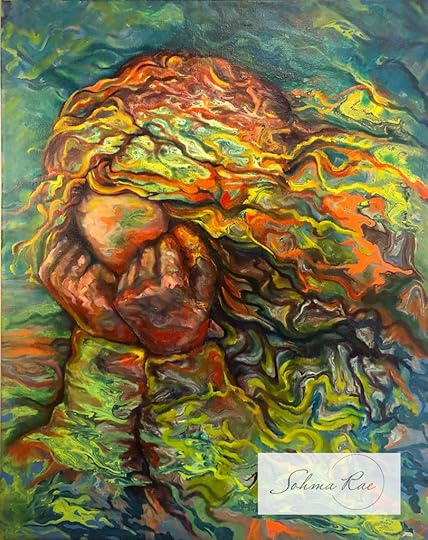 “Behind the Façade” – by Sohma Rae Hathaway. 16X20 mixed media on canvas
“Behind the Façade” – by Sohma Rae Hathaway. 16X20 mixed media on canvasAgony often manifests itself as harsh behavior from the one who is suffering. Be kind to them anyway. Smile, forgive and love to the best of your ability because you won’t always know the challenges they face.
They came for us in the 2020-2022 time period when the world was weakened, and weary.
We have let down our guard. In a post-Trump time, pandemics, economic downturn, climate and ecological breakdown create the perfect environment for AI art to get popular. It’s the ultimate “make art easier” tool. We want our pretty things, our Dopamine hits, and we want them now, and who cares how we get them?
NOW WAIT, I hear you say. YOU SAID IT WAS A TOOL. I have read the arguments that AIs are just another tool like paintbrushes or Photoshop, so why not add to the toolbox? The more tools we have, the larger amount and variety of beautiful art we will have, so what’s wrong with that? AIs are a different sort of implement, along a broad gradient of use types. We could take a toothpick and scratch ink off of a board. We could program a series of cameras to take photos pointed at the sunset for 365 days. We could fling house paint downward, suspended above a huge canvas. I’m not a great fan of every type of art, but I would still categorize it as human-created art. It’s part of culture that we create as artists, with our own backgrounds, training, reasons, and methods.
But AIs are different. If you can’t see how paying $30 for a MidJourney account, then choosing different prompt words, and selecting from the iterations veers from the definition of “artist tool”, then I don’t know how else to describe it to you. You’re not just starting with a texture or reference – you’re sending it off to do its thing without you and then having it present options. I’ve heard the argument that creativity lies in the choices we make with what it produces, but if that qualifies as “creativity” then you and I have a very different understanding of this term.
“Creativity” is what we’re sending the AI off to do for us. It’s going off and scanning the world of images and styles, and synthesizing a new whole image. Isn’t that what goes on in the mind of an artist? This is why the maturity, background, and cultural exposure of an artist are visible in their works.
BUT WAIT! AIs don’t have HEART. It will never show up in what they produce. You can never simulate the ineffable. Oh, haven’t you seen what’s already out there? AIs only need to come CLOSE ENOUGH. And from what I’ve seen, the AI images are close enough, just good enough, to fool people into thinking they are seeing the real thing. Or, put another way, just good enough to serve the artistic purposes we require. Is it “just good enough” to cost a fraction of what hiring an illustrator would cost? So easy. Too easy. You can bet Art Directors everywhere are sitting up and taking notice. One less email, one less phone call, one less 1099 form, sure. This is making our lives easier.
I am fully aware that history is still playing out before my eyes just as it was when my mom held me up to see the moon landing. I know, that even though there are no more “history books” to speak of, and assuming there are future humans left to care to mark historical events, that AI-created art is just one more tragic chapter.
What do artists have left to do? When anyone can type a few words and send our automated slaves off to create images that can be tweaked and used for tarot cards, book covers, and even be entered into art contests and win, what are we even doing, trying to create art by ourselves? By HAND? That would take training and effort, after all. I suppose it was just too difficult, all along.
I guess we’ve automated everything. Even the creative act itself.
Where is the resistance? Exhausted, in survival mode, we’ve lost our will to choose the best world…we only want the easiest. “Culture” fails to carry any emotional currency. We no longer care who makes these things, or why, or whether or not artists can or should make a living, or even what the whole point of humanity is. Our creative urges are fundamental to what makes human intelligence and sentience unique in all the worlds we now know, but we have let those sparks fall in the cooling embers of a dying civilization.
This is the world, the culture, the life, that we’ve made for ourselves. A world where every task has been delegated, automated, and simulated. When there is nothing else left for any of us to do, will then we finally be free?
~ Leah Jay
Postscript: If you feel like humanity should be making different choices, then make a different choice yourself. Support the (human) arts. You know what to do.
About the guests:
 Leah Jay is an artist and illustrator from the Pacific Northwest, who calls herself “an artistic polymath and avid experimenter”. Leah experiments with a variety of mediums: watercolor, acrylic, pastel, ink, fiber, and collage. Her colorful, expressive art has been featured in various publications. Highlights from Leah’s 35-years-long career include directing 2001’s WTC Memorial Art Project to facilitate artists’ responses to 9/11, sharing her piece “Yesterday’s California” on the cover of the Silicon Valley Metro, and successfully crowdfunding her artbook “Amphibian Love” to benefit Save the Frogs. More about Leah can be found at her website — https://leahjayart.com/.
Leah Jay is an artist and illustrator from the Pacific Northwest, who calls herself “an artistic polymath and avid experimenter”. Leah experiments with a variety of mediums: watercolor, acrylic, pastel, ink, fiber, and collage. Her colorful, expressive art has been featured in various publications. Highlights from Leah’s 35-years-long career include directing 2001’s WTC Memorial Art Project to facilitate artists’ responses to 9/11, sharing her piece “Yesterday’s California” on the cover of the Silicon Valley Metro, and successfully crowdfunding her artbook “Amphibian Love” to benefit Save the Frogs. More about Leah can be found at her website — https://leahjayart.com/.
 Sohma Rae Hathaway is an inspiring artist who became Sterling Scholar amidst many challenging odds. She is a true empath who believes that laughter heals the heart and gratitude is just good medicine. Her memoir “Finding Diamonds in Dungeons” is gaining popularity with all 5 star reviews and a ‘best seller’ status. Sohma’s artwork uses bold and beautiful color combinations to convey emotion, most often with allegories or symbols of faith, hope and love. She uses a diversity of mediums from watercolor to oils and has even developed her own technique she calls “chaos refined” using an acrylic base with finishing touches done in oil-based paints. You can contact Sohma directly through social media: Facebook, Instagram or LinkedIn. It’s available wherever books are sold. You can also get the audio version here.
Sohma Rae Hathaway is an inspiring artist who became Sterling Scholar amidst many challenging odds. She is a true empath who believes that laughter heals the heart and gratitude is just good medicine. Her memoir “Finding Diamonds in Dungeons” is gaining popularity with all 5 star reviews and a ‘best seller’ status. Sohma’s artwork uses bold and beautiful color combinations to convey emotion, most often with allegories or symbols of faith, hope and love. She uses a diversity of mediums from watercolor to oils and has even developed her own technique she calls “chaos refined” using an acrylic base with finishing touches done in oil-based paints. You can contact Sohma directly through social media: Facebook, Instagram or LinkedIn. It’s available wherever books are sold. You can also get the audio version here.
The post Is Art Dead? appeared first on How to Sell Art Online | Online Marketing for Artists.
September 12, 2022
Artificial Intelligence Art and Images
Recently, several of my gamer friends have become infatuated with creating art using Artificial Intelligence bots like DALL-E and NightCafe. Last Friday night we sat around and used the tools to create character profiles and some fun scenes like this one from one of our Dungeons and Dragons games.
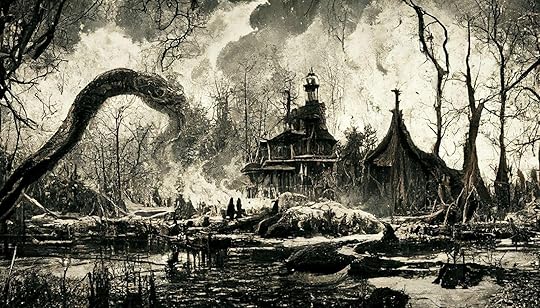 (our party was about to get eaten by a witch polymorphed into a giant snake)
(our party was about to get eaten by a witch polymorphed into a giant snake)Obviously this scene has a few glaring flaws. The giant snake is missing a face, and it was supposed to be a single cottage. Some of the trees don’t make any sense.
Last week I hosted a rousing discussion over on Facebook about the new reality of art created by AI. Opinions were all over the place. The tech is still new and very controversial. We’ve got some opinion pieces coming from artists in favor and against. It’s early, so who knows where things go from here.
Side note: check out John Oliver’s segment on Youtube about AI images for a good laugh.
But here’s the deal: ultimately Artificial Intelligence, (like NFTs and photoshop before) are all technologies – just tools.
Many people complained about digital art when it first hit the scene in the 80s. Artists were widely criticized for using computers and passing off their work as art. But the technology went through many, many iterations and took decades to get the point it’s at now.
But now digital art is considered art. People buy digital art from their favorite digital artists.
You only have to look at the latest rounds of big name auctions or the top trending works on the top art websites to see digital art showing up consistently. Some artists began doing really interesting and original things with those tools. Artists like Cory Arcangel blended digital and physical in interesting ways and made things nobody expected. Artists are pushing boundaries in AR & VR that are selling for big dollars, but even after years and billions of dollars spent, AR/VR are still nascent tech for most artists. The big money is still in physical art, and will be for a long time yet.
Less than a year ago I led a webinar for artists where we talked about what to do with NFTs – and now the crypto art market is selling for pennies on the dollar (though climbing again in some areas).
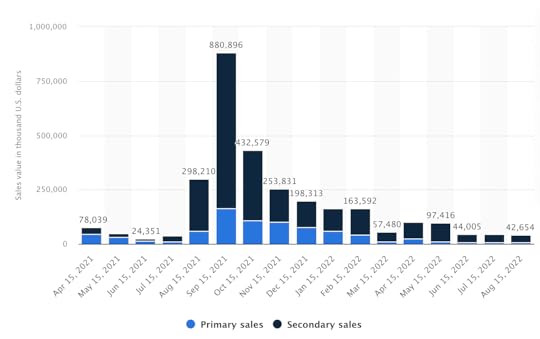 Chart from StatistaRelationships Matter More Than Technology
Chart from StatistaRelationships Matter More Than Technology
Over the weekend an artist I know sent me a text that read, “I just sold a $4k painting to someone who bought a $100 painting from me three years ago. It’s like building relationships pays off!”
And that’s what I want to focus on for the next little two weeks. We’re opening enrollment for How to Sell Your Art Online 101, our flagship course. Our first coaching call is September 26, and it runs through the last week of October. I’ll be sharing links for registration starting tomorrow.
HTSYAO focuses on creating a story that you can use to build connections with people. Even if AI art somehow becomes popular, we’re still years away from art collectors and art enthusiasts pushing it mainstream. Until AI makes significant leaps forward in its ability to make something collectible, artists can continue to stay focused on making good art and building relationships with collectors.
So what’s coming up for you? What questions do you have about AI, NFTs, and selling your art?
The post Artificial Intelligence Art and Images appeared first on How to Sell Art Online | Online Marketing for Artists.
September 1, 2022
Knowing Your Intention: Art and Activism with Genesis Be | TAA Podcast Season 5, Episode 12
Welcome to season five, episode 12 of The Abundant Artist, the show that dispels the myth of ‘the starving artist’, and shares how you can live an abundant life as an artist and make a living from your talent, one interview at a time.
Joining the podcast today is one-of-a-kind artist, Genesis Be. Genesis’ goal with her art is to bring human dignity to the forefront of our divided world; to advocate for compassion, vulnerability, and the burning need for freedom.
“When someone asks me what kind of art I make, it changes by the day. If you were to ask me right now at this moment, I’d say: I make art that reflects my experiences.” — Genesis Be
In this conversation, Genesis highlights and calls attention to the importance of artistic expression from the soul; the connection between activism and art; her personal story of growth, expression, and exploration as an artist; and why it is that she does art. Genesis also shares insights on the importance of trying new things and getting messy, finding the balance in making money while staying true to yourself, and discovering solace in solitude.
In this episode:
[:30] Genesis Be shares about her love for the people of Mississippi and why she sees it as part of her mission to spread the message of love about the people in her state.
[2:40] Genesis highlights examples of what makes the Mississippi especially resilient and inspirational.
[4:47] How Genesis would describe her art.
[6:16] How Genesis’s artistic expression differs in the various mediums she expresses herself in (such as art, music, poetry, theatre, etc).
[11:52] Genesis describes what an NFT is and why she began to engage with the blockchain as an artist.
[14:34] The importance of trying new things as an artist and not being afraid of getting messy.
[15:00] Genesis shares about her favorite videogame.
[16:58] About the powerful and important activism work Genesis has been doing throughout her life.
[22:09] Why Genesis paints stick figures that interact with barriers; her artistic mission statement.
[27:49] Genesis’s insights into why our youths’ mental health is eroding and the main drivers at play.
[32:21] Genesis’s experience with finding solace in loneliness and solitude.
[36:00] How writing played a key part in Genesis’s journey early on.
[37:50] The difference between art on social media vs. in person.
[41:24] How Genesis makes a living and supports herself financially as an artist.
[43:29] Genesis’s advice to other artists on making money.
Resources mentioned:
Genesis Be
Mississippi Rising Coalition
VyZen
“We Are Mississippi | Theo Sutton Interview”
Soledad O’Brien
About the guest:
 Genesis Be is a critically acclaimed Hip Hop performer, activist and painter from Biloxi, Mississippi. Her work has been featured in The Associated Press, New York Times, NY Daily News, and VICE. She often uses theatrical protest during her live performances to bring attention to both global and localized issues surrounding racial justice, peace movement, queer visibility and gender equity. She creates original paintings, poetry and music under her ever growing collection, People Not Things.
Genesis Be is a critically acclaimed Hip Hop performer, activist and painter from Biloxi, Mississippi. Her work has been featured in The Associated Press, New York Times, NY Daily News, and VICE. She often uses theatrical protest during her live performances to bring attention to both global and localized issues surrounding racial justice, peace movement, queer visibility and gender equity. She creates original paintings, poetry and music under her ever growing collection, People Not Things.
The post Knowing Your Intention: Art and Activism with Genesis Be | TAA Podcast Season 5, Episode 12 appeared first on How to Sell Art Online | Online Marketing for Artists.
August 19, 2022
Artwork Archive Review: Inventory Management in 2022.
Imagine you are a prolific artist who has created hundreds of paintings and sculptures. You have sold hundreds of pieces and they have moved around the world, displayed in private and public collections. You also have pieces in museums and on display in various galleries, coffee shops, boutiques, and other places. Maybe you even have a few pieces that are licensed to major retailers.
How do you keep track of all of that?
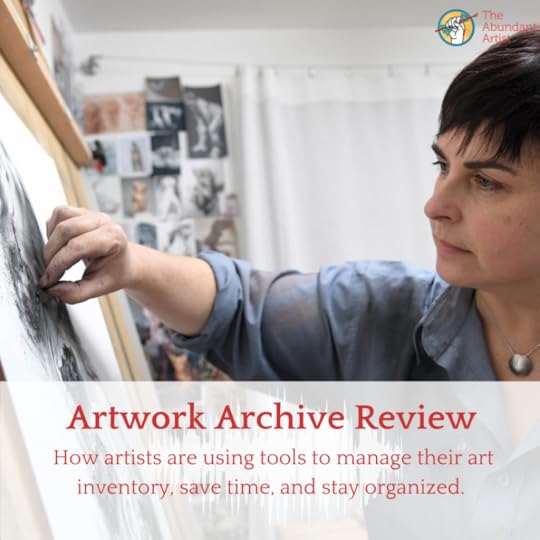 Artist Tansy Lee Moir. Photo credit Sheila Masson.
Artist Tansy Lee Moir. Photo credit Sheila Masson. Some artists do it with spreadsheets. That quickly becomes cumbersome and requires quite a bit of manual updating, and still leaves a lot of work to be done when it comes to labeling, creating certificates of authenticity and other routine activities for artists.
Many companies have attempted to create better tools, and we’ve reviewed several of them. We’ve reviewed Artwork Archive before but it’s been a few years. I recently reconnected with their team to get an update on their platform.
Sign up for Artwork Archive here*.
What is Artwork Archive?In their own words, ”Artwork Archive provides artists, collectors and organizations
powerful tools to manage their artwork, career or collection.” Those tools include one place to input images, dimensions, weight, location, creation date, medium, price, and more information about your art.
That data can then be used to create collections, track reproductions, and create private collections that can only be viewed by specific collectors or licensing buyers.
You can also track the provenance of each piece, including not just the creation date, but also any exhibitions and who has purchased the work. This information can be used to generate certificates of authenticity or simply sent to buyers and curators so they have a history of the work.
This one place to put all your data solution is common enough, but the consistent feedback we received from artists was that there are two features that set Artwork Archive apart: collections and inventory reports.
Private & Embedded CollectionsCollections of art are easy to organize in Artwork Archive. That’s the core function after all. Artwork Archive allows you to take this to the next level by publishing those collections to the web, either publicly or privately with a password requirement.
Public collections can be used to show what’s available, what’s sold, what’s on display at a museum, or any other combination. Private collections would be used (for example) to show a collection of works available for licensing or to show works in progress to give your most important collectors early access. Public and private collections can be embedded on websites with a simple copy & paste HTML snippet.
Inventory Reports & Tear SheetsIf you’ve ever gotten ready for an exhibition and realized you need to create info sheets for each work on display you know the pain of having to hand write or retype that sheet. With AA you can just find the work, click a button and print a tear sheet with the selected info on it for everything that’s for sale.
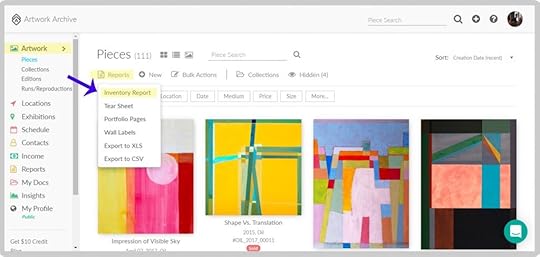
And just in case you were wondering if it’s going to be a nightmare to transition from your existing spreadsheet to Artwork Archive, there is a bulk uploading feature.
There’s a lot of features built into that monthly subscription (currently $8 – $24 per month, depending on the plan level). We won’t touch on all of those features here as you can easily read the list on their website. Instead here we will focus on how artists are actually using the platform.
How Artists Actually Use Artwork ArchiveWe asked artists who use Artwork Archive the following questions:
What made you realize you needed to get your inventory organized?What do you like about Artwork Archive?What about the platform needs work, or what do you wish it did?Below we’ve shared selections of some of the most useful feedback from artists.
What made you realize you needed to get your inventory organized?
Early in their career, many artists don’t even bother to create an inventory of their work. It’s overwhelming enough to just make and sell the work. Most of us don’t think about our legacy or estate until much later in life, which means that creating an art inventory can feel overwhelming.
Tansy Lee shared a common story about preparing for an exhibition, “I was selecting and packing work to send to an exhibition. I needed about 6 pieces and had an idea in my mind which ones they should be, but I was struggling to find one charcoal work in particular. I had the images I needed in my digital catalogue but just couldn’t find the actual artwork. Frustrated, I searched my studio for an hour or more, had some cups of tea while trying to remember it, looked everywhere in the house and felt very annoyed at my own inefficiency. Eventually it dawned on me that I had actually sold it 3 years before and it now lived in Manchester!
This made me see I was going to need a better system if I had any hope of keeping track of my work – after 10 years of making, my cobbled together process of documenting work was no longer up to the job. I realised that I would need a much more reliable and professional system to support my art making, ideally one which saved me time spent on the tedious admin tasks we have to do to sustain our practice.”
What do you like about Artwork Archive?
Tania Hillion said, “First thing first, it does a great job to archive my artworks with multiple photos references, video links, categories for sizes, automatically making the conversion from inches to cm…these are small things but when you are seeking for a specific info, it is gold to have a quick and easy access to these data.”
She went on to explain, “On Artwork Archive I create as many ‘collections’ or artworks, that can be translated to groups of artworks that I want to display indifferent categories. Then the tool gives me a little piece of html code that I just need to copy/paste on my wordpress website to display the selection(s) on my website.”
That means any time you update info in your inventory (like a new museum or private collection location), it’s automatically updated anywhere your art is public.
Several artists also prased the invoicing feature built into Artwork Archive*. With all of the art info already there, it’s easy to enter collector info and send them an invoice. When they pay, your collection is updated and you have a central location to keep info on your collectors. Artwork Archive acts as a Customer Relationship Management database, showing you who has what works, when they were purchased, and other important information.
You can also leverage all of this information to create private collections for things like commission works in progress or works available for licensing, where collectors and art buyers can make comments.
What about the platform needs work, or what do you wish it did?
The public collections feature is popular but many artists pointed out that it is not a substitute for a website. There’s not a built-in ecommerce feature like Shopify or Woocommerce. If you plan to make a significant effort to sell art online, you’ll need something in addition to Artwork Archive, which means managing two different inventory systems.
The CRM system (contact management) is fairly minimal and doesn’t include some key features that would put it on par with something like Salesforce or Zoho. The biggest missing feature is email integration. In most CRMs you can add an email to your BCC line that copies the email response into your CRM so you can view your communication history in your CRM, but that’s not possible with Artwork Archive.
Neither of these things take away from Artwork Archive’s primary function: being a great inventory management system. I would hope to see some level of integration with common shopping solutions in the future, but integrations like that are expensive and time consuming to maintain and are typically only built by much larger companies.
Featured Artist Bios & ArtMany artists gave input for this article, but special thanks go out to two particular artists for sharing detailed feedback.
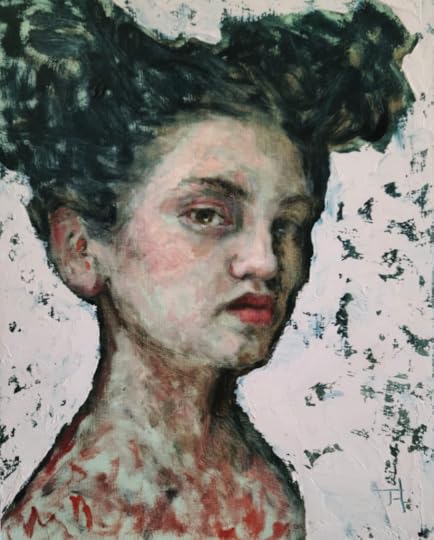 Tania Hillion is a French artist based in Quebec (Canada) who uses oil painting as the predominant medium to address the notion of perceptual memory. Figurative portrait painter, she is self-taught. Website.
Tania Hillion is a French artist based in Quebec (Canada) who uses oil painting as the predominant medium to address the notion of perceptual memory. Figurative portrait painter, she is self-taught. Website. 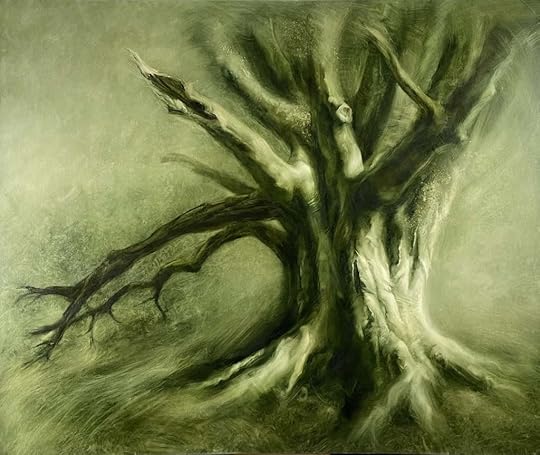 Tansy Lee Moir is inspired by the forms and stories of old trees, by the way humans, animals and natural processes have shaped them. It encourages us to look at trees in new ways and to think about our ancient, layered relationships with them as living organisms. Website. Should You Use Artwork Archive?
Tansy Lee Moir is inspired by the forms and stories of old trees, by the way humans, animals and natural processes have shaped them. It encourages us to look at trees in new ways and to think about our ancient, layered relationships with them as living organisms. Website. Should You Use Artwork Archive? Hopefully this review gives you an idea of what you can do with Artwork Archive*. If you are early in your career we highly recommend you keep an inventory of your work, even if you’re not paying for a product yet. We think Artwork Archive offers an organizational framework that is the best in the market and adds some useful tools on top of that.
If you’ve created more than 50 pieces of art and are actively selling your art regularly, Artwork Archive is going to make your life easier, save you time, and help you make more money.
* = Affiliate Link. TAA may receive a small commission if you sign up for Artwork Archive. We only recommend products that we think are great for artists.
The post Artwork Archive Review: Inventory Management in 2022. appeared first on How to Sell Art Online | Online Marketing for Artists.
July 28, 2022
Rediscovering Your Passion and Getting Back to Your Roots as an Artist with Flora Bowley | TAA Podcast Season 5, Episode 11
Welcome to season five, episode 11 of The Abundant Artist, the show that dispels the myth of ‘the starving artist’, and shares how you can live an abundant life as an artist and make a living from your talent, one interview at a time.
Returning to the podcast today is Flora Bowley! Flora is a painter, pioneer, permission-giver, and author of four books: The Art of Aliveness, Brave Intuitive Painting, Creative Revolution, and Fresh Paint. She believes that creativity has the power to awaken, empower, heal, and transform; and that you have everything you need right now to reignite your creative fire.
Blending over 25 years of professional painting experience with her background as a yoga instructor, healer, and lifelong truth seeker, Flora shares her advice for creating art intuitively, letting go, and rediscovering your love of art (without getting caught up in the technicalities and perfectionism). She speaks about what we can do to get unstuck, how she guides artists through artistic exploration in her retreats, her wisdom around staying connected to your creativity, and more.
“If we’re really talking about, ‘What is the purpose of art?’ I think it’s to move people. And what moves people is honesty, and reliability, and beauty, and rawness.” — Flora Bowley
If you’ve been feeling the pressure around creating art and are struggling to let loose, have fun, and reconnect with why you began creating art – this episode is for you! As a retreat leader and guide for other artists, Flora has incredible insight into what it takes to reignite your love for creating and connecting to your artistic expression.
In this episode:
[:30] Cory welcomes Flora back to the podcast!
[:52] Flora shares about what she has been up to since her last appearance on the podcast.
[2:55] About Flora’s new retreat center.
[5:05] What kind of retreats has Flora historically led? How have the retreats that she runs now shifted? Why does she love doing retreats?
[12:40] Flora shares what she believes the purpose of art is, and how she guides artists in creating raw, beautiful art from their souls.
[14:37] Bringing the art of creativity to non-artists. Flora’s advice on reconnecting to love of simply creating without getting caught up in the technicalities and technique.
[19:37] What inspired Flora to buy her own retreat center? What inspires her to do this work?
[26:22] The silver lining of the pandemic with regards to creating, change, and community.
[28:27] About the two books that Flora published during the pandemic.
[30:26] Flora shares about what it was like to transition from writing about painting to writing about ideas for her newest book.
[34:23] About Flora’s painting book that she released during COVID, Fresh Paint.
[37:03] The artist paradigm.
[41:01] Cory’s book recommendations.
[42:04] What art may come out of the great resignation? Why are artists and non-artists craving simplicity?
[45:19] What mindfulness looks like to Flora and how she engages in it.
[47:50] How does Flora exercise/move outside of creating?
[50:18] Where to learn more about Flora.
Resources mentioned:
Flora Bowley’s Books
Flora’s Spotify List
“Brave, Intuitive Painting Careers with Flora Bowley” – TAA Podcast
“What It’s Like to Sell 100,000 Paintings with Jose Trujillo” – TAA Podcast
Essentialism: The Disciplined Pursuit of Less, by Greg McKeown
Effortless: Make it Easier to Do What Matters Most, by Greg McKeown
About the guest:
 Flora Bowley is an artist, gentle guide, and author of four books — Brave Intuitive Painting, Creative Revolution, Fresh Paint, and The Art of Aliveness. Flora’s soulful in-person retreats and generous online courses are informed by the belief that we all have infinite wells of creative potential which can serve as fuel for a more alive and awakened way of living. Currently, Flora is pouring her creativity and passion for community and connection into building a holistic retreat center an hour outside of Portland, OR. Find out more at www.florabowley.com.
Flora Bowley is an artist, gentle guide, and author of four books — Brave Intuitive Painting, Creative Revolution, Fresh Paint, and The Art of Aliveness. Flora’s soulful in-person retreats and generous online courses are informed by the belief that we all have infinite wells of creative potential which can serve as fuel for a more alive and awakened way of living. Currently, Flora is pouring her creativity and passion for community and connection into building a holistic retreat center an hour outside of Portland, OR. Find out more at www.florabowley.com.
The post Rediscovering Your Passion and Getting Back to Your Roots as an Artist with Flora Bowley | TAA Podcast Season 5, Episode 11 appeared first on How to Sell Art Online | Online Marketing for Artists.
July 5, 2022
Why We Switched to ConvertKit from Mailchimp
I’ve used a LOT of email marketing tools. I’ve worked in marketing in various industries for 15 years, and I have tested a number of tools with The Abundant Artist. There are a lot of email marketing tools, many of them purpose-built for large companies or to do very complex tasks that 90% of artists will never need.
What most artists need when it comes to email marketing tools is something that is easy to use, simple, but powerful enough to grow with your audience. In the past we’ve recommended Mailchimp, but they’ve become a large behemoth with a tool that is heavy-duty and quite confusing. They were also recently acquired by Intuit, a company famous for acquiring great software and making it worse (RIP Mint, my favorite personal finance tool).
We also considered alternatives like ActiveCampaign (more expensive), Mad Mimi (too simplistic), Hubspot (too complex), Constant Contact or AWeber (too old and out of date), Substack (too political) and Drip (explicilty going up market to serve bigger ecommerce customers).
Why We Recommend ConvertKit for ArtistsConvertKit is an Email Service Provider (ESP). They send emails to large numbers of people for you. There’s a lot of reasons you’ll want to use an ESP over just sending from your personal gmail account, but the biggest one is that your personal email provider doesn’t allow email marketing activities (this is included in your terms of service).
We like ConvertKit over other providers for a few reasons.
They are built explicitly as a marketing platform for creators . TAA uses ConvertKit. If you’re on our list, you’re getting an email from ConvertKit. ConvertKit specifically supports artists, writers, musicians, and other creators. Simple & Easy. We used to recommend Mailchimp, and that’s still a great platform. But part of the reason we like ConvertKit is the fact that it’s simple and easy to use. Other platforms are more powerful, but especially if your business is small, you don’t need all of that complexity. We know them. Nathan Barry, founder of ConvertKit, helped me get my first book deal. He literally emailed his agent and introduced me, which led directly to the publication of How to Sell Your Art Online with Harper Collins about a year later. I’m friends with several members of the current and former team. They’re good people that I trust to take care of you. In addition, they’re a privately owned company that isn’t beholden to investors, so their customers are their top priority. We make a little money from recommending them. Full disclosure: we have an affiliate relationship with ConvertKit and make a small percentage on any paid accounts we refer. We would recommend them anyway, since ConvertKit is what we use.Here’s a few examples of the core features that ConvertKit does well.
Sending EmailsThis is obviously the basic function. It’s very easy to create simple, elegant emails in ConvertKit. Note that we often teach artists to create simple, undecorated emails that focus on the artwork, rather than elaborately designed templates. This is for a variety of reasons, primarily the fact that simple emails usually perform better than elaborate designs.
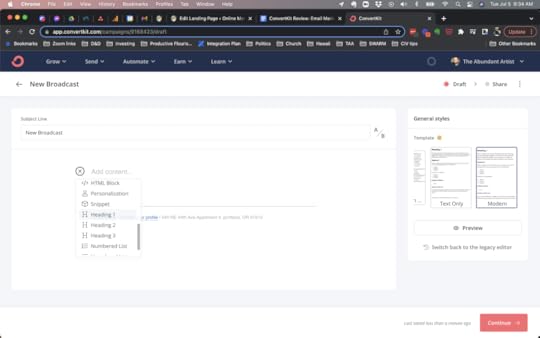 List Building: Forms, Pop Ups, and Landing Pages
List Building: Forms, Pop Ups, and Landing Pages ConvertKit makes it easy to set up email marketing opt-in forms like this:
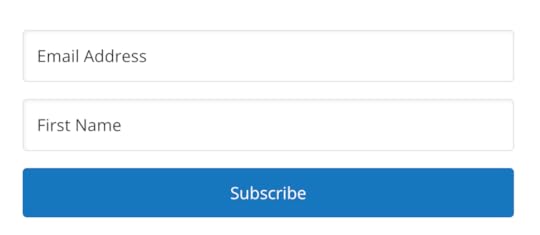
It took five minutes of setup inside Convertkit’s website to create, and then all I had to do was paste a single line of text like this onto the page I wanted it displayed.
Metrics
While email open rates for any service are no longer a terribly reliable performance metric, ConvertKit does a great job of surfacing open and click rates, and making it easy to understand how your list is growing (or shrinking). This image is from a recent email to our list:

This graph shows daily opt-ins and unsubscribes for TAA’s list.
 Easy to Switch and Get A Fresh Start
Easy to Switch and Get A Fresh Start

In the month of July, ConvertKit is running a special fresh start program that includes 30 days free and other bonuses.
Those other bonuses include an email strategy series, an email marketing strategy call, and if you have ore than 5,000 people on your list, they’ll do a custom audit to make sure your migration is set up in a way that works best for ConvertKit.
Tips for Artists Switching to ConvertKitIf you’re switching from Mailchimp, you’ll want to export your existing lists. Here’s the instructions for exporting from Mailchimp. If you’re just getting started, you’ll want to assemble your list.
From our blog post guide on email marketing for artists:
Collect names, email & (optional) physical addresses. When your work is shown at art shows, craft fairs, galleries, and other places, put out a sign up sheet for people to opt-in to your mailing list. Write something like this on the top of the page, “Join my collector list to find out more about my upcoming work and studio process.” Then divide the paper up into three columns labeled First Name, Email, and Address.
To get started, put those addresses into a spreadsheet or csv file (here’s a template). Then upload that file when you set up your ConvertKit account.
This page from ConvertKit has a video that shows you Adding & Importing Subscribers in their system.
How do I tag & segment my list?Check the Tags & Segments video on the ConvertKit onboarding page to see how tags work inside of ConvertKit.
Learn More About Email Marketing for ArtistsWe have LOTS of resources on how to be successful with email marketing as an artist, ranging from free to paid.
If you’re new to email marketing, check out our free Email Marketing for Artists Challenge. That will get you up and running with your first email campaigns in less than 8 days.
If you want to learn more about email marketing and get some basic tips, we’ve got several blog posts:
The Ultimate Beginner’s Guide to Email Marketing for ArtistsHow to Use Your Email List to Sell Art How Many People Do You Need On Your List?5 Steps to Better Email Marketing for Artists7 Email Marketing Scripts for Artists23 Things to Talk About in Your Artist NewsletterHow Are Other Artists Using ConvertKit?Email is a constantly evolving, ever-changing process. The best way to get good at it is to subscribe to some of the most effective artists’ email lists and see what they’re doing. Here are two case studies of artists who do email well. We will be adding more examples in the future.
Shelby Abrahamsen has a case study on ConvertKit’s blog and is also featured on CK’s Creator Sessions.
Adam Hall is very good at email marketing. Case study with TAA.
The post Why We Switched to ConvertKit from Mailchimp appeared first on Online Marketing for Artists.
June 23, 2022
What It Costs to Run an Art Gallery | TAA Podcast Season 5, Episode 10
Welcome to season five, episode ten of The Abundant Artist, the show that dispels the myth of ‘the starving artist’ and shares how you can live an abundant life as an artist and make a living from your talent one interview at a time.
“I realized that stopping before I was done, especially with the process-oriented thesis where I’m not completely in control. I’m like in peripheral control of what’s. Not all mine. That leaves room for the viewer to come into it when everything’s locked down and every detail is nailed down. I find that work can often be less engaging. If it’s got a little space where you can enter into its imperfections maybe, or it’s question marks. That seems to go along well with the idea of being process-driven.” – Blair Vaughn-Gruler
In this episode of The Abundant Artist Podcast, we are joined by artist and gallerist Blair Vaughn-Gruler. Blair and her husband, Ernst Gruler, are owners of GVG Contemporary located in Santa Fe, New Mexico. For the past ten years, the gallery has been representing a carefully curated selection of evolving abstract and nonobjective Arts as well as fun, figurative, and functional sculpture that explore materiality.
Join us as Blair discusses her process-driven works, sharing her thoughts on how art makes her evoke emotions, how to work better with gallery owners, and offers tips for taking yourself seriously as an artist.
Let’s tune into her story!
In this episode:
[00:00 – 12:13] A Conversation Between the Media and The Artist: A Process-Driven Work
Painting helps you organize your brain chemistryHow it becomes a process-driven work, and a conversation between an artist and its mediumBlair describes how her work responds to her and vice versa. She responds emotionally and intellectuallyThe media responds through her process as shown by mark-makingBlair answers how she decides to finish or abandon a piece that is processedShe exhausts all resources. And makes sure to leave a room for the viewer to come intoShe believes when every detail is nailed down, it would be less engaging than those of that who has a little imperfections and question marks around itArtist observes that this accessibility comes from the physical sensation of the work, which helps evoke emotionShe shares her breakthrough moment when they were in graduate school and how felt engaged with her paintings“I actually felt like I took them in through my body instead of my intellect” – Blair Vaugh-Gruler
[12:14 – 24:10] How to Work Better with Gallery Owners
Working with galleries can be difficultBlair shares tips for avoiding rejection in the Art WorldResearch to find out if the gallery is interested in artists, and if they have a submission processBe ready with a good body of work and be willing to put in the effort to build a relationship with the GalleryThe many costs of running a gallery, and how it can be difficult to make a profit[24:11 – 31:40] Expenses of Being an Artist
Living in Santa Fe, New Mexico, Blair points out that there are many expenses associated with being a successful artist in the city: payroll, advertising, networking fees, shipments, and insuranceIt’s important to established a good gallery relationship if you want to be successfulA good gallery will have salespeople and administrative staff as well as researchers to help you choose the right art pieces for your gallery[31:41 – 35:31] “Discovering the Art Genealogy of Your Favorite Artists”
Genealogy is one of Blair’s passionsBlair’s journey into abstract expressionism was influenced by artists like Jackson PollockFor the author, following the lineage of an artist is important to gaining confidence in one’s own workBlair recommends reading books or watching films about the artists mentioned in the show[35:32 – 38:22] Closing Segment
Key quotes:
“You can put water media on there and it’s going to suck the pigment into the clay, but you can’t control it. So that’s what makes it a conversation like I do this, it does that. I go, oh. That’s not what I meant. Okay. Now I have to do this and now it does that. And that’s where the conversation comes from. That is the fun part for me” – Blair Vaughn-Gruler
“You have to do some research. you have to figure out where you might want to be.” – Blair Vaughn-Gruler
“I think it’s easy to get too focused on the commodity factor, The commodity, getting the physical object and, getting that sold to sort of throwing the baby out with the bath water, because what everybody’s looking for in the making and the collecting. Are sort of the connection and the intangible glimpse into the mystery of creativity” – Blair Vaughn-Gruler
Resources mentioned:
Agnes Martin
Jackson Pollock
See Blair Vaughn-Gruler works at gvgcontemporary.com
About the guest:
 Blair Vaughn-Gruler makes paintings that are driven by procedure and process. Accumulation, repetition, erasure and the physical motions made in the process of mark making harken back to her many years practicing martial arts, and foregrounds the body’s relationship to painting. A Michigan native and New Mexico transplant, Vaughn-Gruler has been obsessed with paint since childhood. Her spare, non-objective compositions are exercises in organizing space. Even when shapes or lines repeat themselves to excess, a calm arises out of the chaos. As the conceptual love child of Cy Twombly and Agnes Martin, Vaughn-Gruler (born in 1955) makes paintings to reconcile her early modernist training with the lived experience of the information age. She holds a BFA in painting from Northern Michigan University and an MFA in Visual Art from Vermont College of Fine Art.
Blair Vaughn-Gruler makes paintings that are driven by procedure and process. Accumulation, repetition, erasure and the physical motions made in the process of mark making harken back to her many years practicing martial arts, and foregrounds the body’s relationship to painting. A Michigan native and New Mexico transplant, Vaughn-Gruler has been obsessed with paint since childhood. Her spare, non-objective compositions are exercises in organizing space. Even when shapes or lines repeat themselves to excess, a calm arises out of the chaos. As the conceptual love child of Cy Twombly and Agnes Martin, Vaughn-Gruler (born in 1955) makes paintings to reconcile her early modernist training with the lived experience of the information age. She holds a BFA in painting from Northern Michigan University and an MFA in Visual Art from Vermont College of Fine Art.
The post What It Costs to Run an Art Gallery | TAA Podcast Season 5, Episode 10 appeared first on Online Marketing for Artists.
The Abundant Artist Goodreads blog
- Cory Huff's profile
- 31 followers


